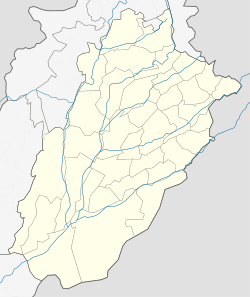Nankana
|
Nankana Sahib ننكانہ صاحِب |
|
|---|---|
| City | |
 |
|
| Coordinates: 31°27′0″N 73°42′24″E / 31.45000°N 73.70667°ECoordinates: 31°27′0″N 73°42′24″E / 31.45000°N 73.70667°E | |
| Country | Pakistan |
| Province | Punjab |
| District | Nankana Sahib |
| Elevation | 187 m (614 ft) |
| District Council | 3 seats |
Nankana Sahib (Punjabi and Urdu: ننكانہ صاحِب) is a city and capital of Nankana Sahib District in the Punjab province of Pakistan. It is named after the first Guru of the Sikhs, Guru Nanak, who was born in the city and first began preaching here. Today it is a city of high historic and religious value and a popular pilgrimage site for Sikhs from all over the world. It is located about 80 km (50 mi) west of Lahore and about 75 km (47 mi) east of Faisalabad. The city has a population of approximately 70,000.
The township was founded by Rai Bhoi and thus was known as Rai-Bhoi-Di-Talwandi. His great-grand son Rai Bular Bhatti, renamed it as 'Nankana Sahib' after the birth of Guru Nanak. The Gurdwara Nankana Sahib, originally constructed in around 1600 CE was renovated in 1819–20 CE by Gian-Punjab Maharaja Jassa Singh Ramgarhia The Sikh Conference of Panjab, Jammu and Kashmir, Peshawar, Kangra and Hazara.
During the Akali movement, on 20 February 1921, Narain Das, the Udasi mahant (clergy) of the gurdwara at Nankana Sahib, ordered his men to fire on Akali protesters, leading to the Nankana massacre. The firing was widely condemned, and an agitation was launched until the control of this historic Janam Asthan Gurdwara was restored to the Sikhs. Again in the 1930s and 40's the Sikhs added more buildings and more architectural design.
Migration between India and Pakistan was continuous before independence. By the 1900s Western Punjab was predominantly Muslim and supported the Muslim League and Pakistan Movement. After independence in August 1947, the minority Sikhs and Hindus migrated to India while the Muslim refugees from India settled in the Western Punjab and across Pakistan.
...
Wikipedia


